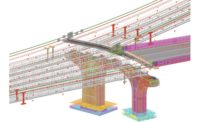New Tools for Turning Photos Into Lifelike 3D Models

Aerial images of a quarry are digitally stitched into a 3D model with ContextCapture, a new software from Bentley Systems that is based Acute3D’s technology.
IMAGE COURTESY OF BENTLEY SYSTEMS INC.
Two new software products for rapidly converting collections of photos into 3D models and rapidly creating realistic environments for those models—one called ContextCapture, the other called LumenRT—demonstrate technical sophistication, data management techniques, rendering speed and ease of use that has reviewers taking notice but asking for more validation, too.
“Can it compare to LiDAR? I want to know the worst, best and average accuracy to know how I can use it in construction,” says Jia Gong, assistant professor at Rutgers University School of Engineering. In early November in London, Gong saw the products demonstrated at Bentley Systems Inc.’s 2015 “Year in Infrastructure” conference, where the company announced the software release.
“ContextCapture’s ability to stitch together photos and develop an accurate mesh is hard to even think about mathematically,” adds William Pratt, transportation principal engineer with the Connecticut Dept. of Transportation. He has experimented with a trial version of the product and likes its speed.
“The accuracy is dependent on the operator,” says Jean Philippe Pons, a director of software development at Bentley and former CEO of Acute3D, the company that developed the technology behind ContextCapture. Bentley acquired Acute3D in February. Pons says the software automatically matches pixel patterns from adjacent images to join the photos into a 3D model. The higher the resolution of the photos and the closer to the target they’re taken, the higher the quality of the model. If done correctly, the accuracy can be to the millimeter, says Pons.
“ContextCapture doesn’t require special equipment or surveyors. You just take some photos, and the software gives you a navigable 3D model,” says Bentley’s Huw Roberts, vice president of platform advantage. The “reality mesh”—that is, the resulting 3D model—is not just for visualization; it can produce an engineering-grade model, he adds. Roberts says, “You can apply data to it”—and therein lies the power. “Everything from census data, real estate property data and BIM asset IDs can be added.”
But high-resolution images mean large files, and lots of large files can put heavy demands on computers. To manage that magnitude of processing, Bentley employs a strategy called grid computing. If users need to process models of very large sites, such as an entire city, or even multiple smaller sites that are highly detailed, they can create a processing grid by linking together computers to distribute the work, says Pons. ContextCapture Center, an extension of the ContextCapture product, provides tools to help firms set up computing grids to keep big processing jobs in-house.
The other new product, LumenRT, augments 3D models by adding visually rich, real-world environmental details, such as moving cars, shadows, trees and fog. LumenRT is based on software developed by another Bentley acquisition, e-on, which created a computer-graphics engine to do large-scale landscape renderings for films, including “Avatar” and “The Hunger Games.” It renders in real time with no delay, says David Burdick, Bentley industry executive for visualization. Bentley announced its acquisition of e-on on Sept. 14.
Burdick says construction won’t use the software the same way the film industry does, but it can benefit from e-on’s ability to deliver quick visualizations.
LumenRT can place almost any 3D model, including models from SketchUp, Revit, MicroStation and ArchiCAD, in a realistic landscape, complete with snow, shadows and tree branches waving in the wind. The software can show how models will look in any season or time of day. It also comes with an in-depth library of pre-designed 3D elements and delivers realistic visualizations of interiors, he says.
ConnDOT’s Pratt was impressed. “What you used to have to do was to set things up to render—and then go wash your car, because it took hours,” he says. “This is real time.”





